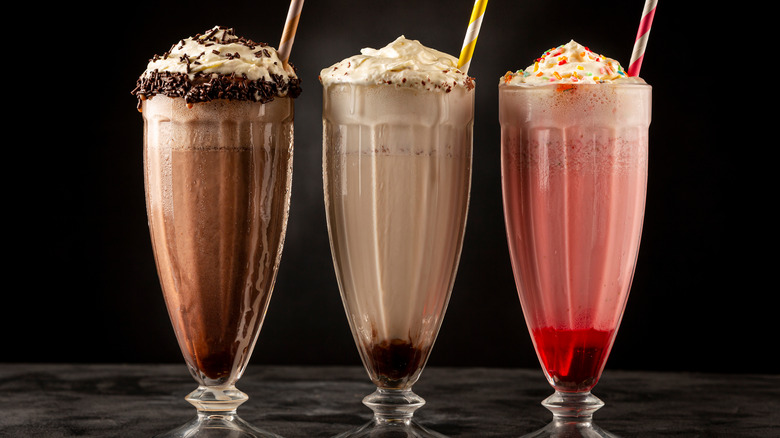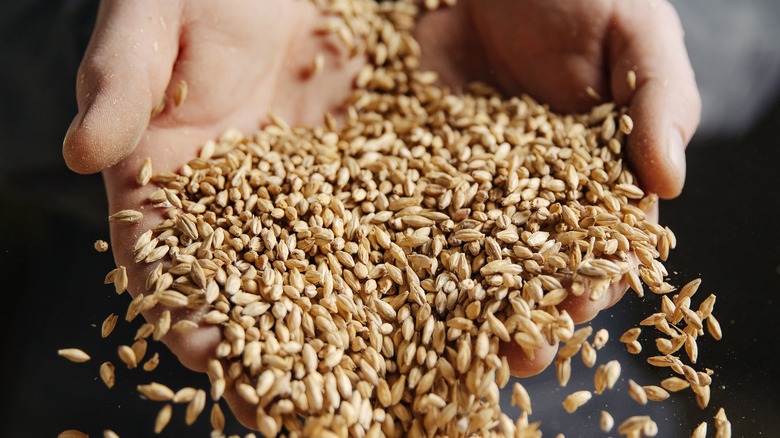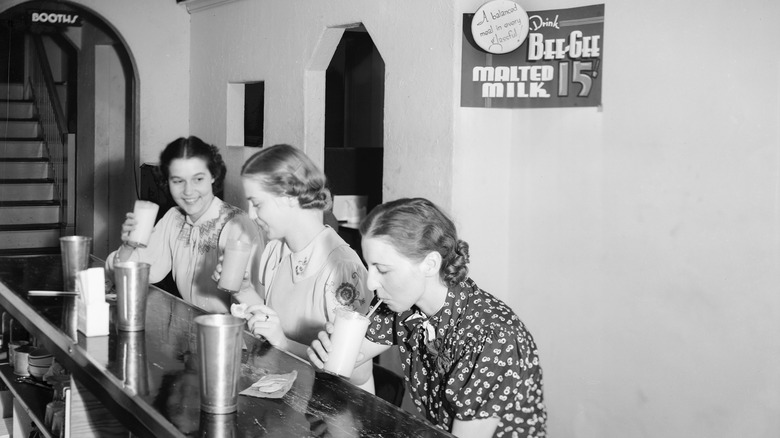What The Malt In A Milkshake Really Is
When you think of malt, you may imagine the nutty flavor of malted whiskey or even malted beer. Or you may think of a rich, frothy shake that could be served at a vintage soda fountain, or perhaps you think of "Whoppers," a malted milk ball candy. If you are a keen baker, you may have even made bread using malt powder. So what exactly is malt, and how is it equally at home in a chocolate malt milkshake as it is in Vegemite? All of these uses of malt are related, and it all starts with a toasted grain, usually barley.
Malt refers to a food product made by partially germinating and then roasting grains. It's an extremely versatile ingredient used in beer brewing, confectionery, baking, and even in milkshakes. People ate (or drank) malt since before Egypt's pyramids were built, according to the Maltsters Association of Great Britain. The ancient Egyptians used it both in beer brewing and bread making like many people today, but, of course, the malted milkshake came much later.
The malt used in a malted milkshake is actually malted grain powder mixed with powdered milk and sometimes salt, sugar, or chocolate. When added to milkshakes, it provides a hint of that toasted nutty flavor. William Horlick created "malted milk powder" in the 1880s, which was used as a nutritional supplement for infants and adults. By the 1920s, malted milk and malted milkshakes (ie milkshakes mixed with malted milk powder) had become a popular refreshment served at pharmacy soda fountains. Eventually, malted milkshakes became known simply as "malts" and soda shops and fountains became "malt shops."
A malted shake starts with malted grains
Malted grains are used in many ways, including in brewing beer and distilling spirits like whiskey. Malt is basically a dried grain that is soaked and allowed to sprout, then it is dried, toasted, roasted, or kilned. Barley is the most popular malt grain, but some use rye, corn, or just about any other grain.
This process kickstarts the breakdown of grain starches into a sugar called maltodextrin, and the toasting creates a caramel color, which develops through the Maillard reaction. You also see this browning reaction at work when you caramelize onions or toast bread, it comes from an interaction between amino acids and sugars during cooking. Both the sweetness and hue are desirable to brewers and distillers since the sugar helps with fermentation and the malt gives certain beers and spirits their appealing colors.
Of course, brewing and distilling are not the only uses for malted grains. Bakers often use malt syrup in baked goods and confectionery as well. As such, malt is available in a few forms, including powdered or liquid malt extract and malt syrup, which is made by cooking sprouted grains and reducing the solution into a concentrated sweetener. While malt is very useful in the kitchen, brewery, and distillery, it isn't milkshake-ready itself; instead, you'll need malted milk powder for that shake.
How malted milk powder is made
Creating malted milk powder is a multi-step process that starts with a maltster creating a malt extract, which is then dried into a powder along with milk. William Horlick originally made his malted milk powder by drying whole milk, malted barley, and wheat extracts using a vacuum, according to the Los Angeles Times.
This creates plain malted milk though, and for many popular malt shakes, candies, and confections, there's another important ingredient in the mix: chocolate. Swiss chemist Albert Wander created an early version of Ovaltine in 1904, by combining malted milk, egg, and cocoa powder, per the Swiss National Museum. The chocolate complements the nutty flavor of malt, making chocolate milkshakes taste even richer. If you are making a malted shake, you have the choice between using classic plain malted milk powder or the chocolate-added version, and either option works with the full range of flavors.
This sounds complicated on a commercial scale, but it's actually possible to make malted milk powder at home by germinating and drying grain seeds and mixing it with dried milk powder and cocoa if you prefer. From there you can use it in milkshakes, hot chocolate, as a topping for popcorn, or to enhance flavors in baked goods. But whenever you use your malted milk you join people dating back to ancient Egypt who supplemented their food by consuming malted grains.


